2023年中考英语复习 8年级下册 Unit 7~Unit 8课件(共39张PPT)
文档属性
| 名称 | 2023年中考英语复习 8年级下册 Unit 7~Unit 8课件(共39张PPT) |
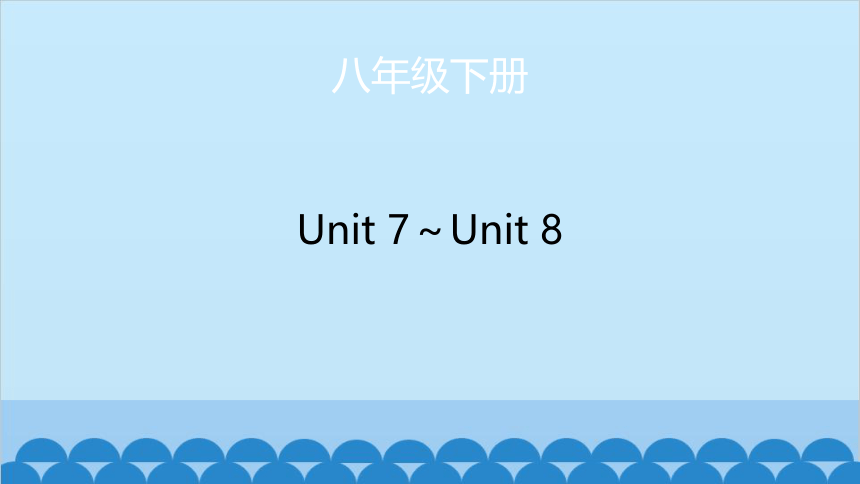
|
|
| 格式 | pptx | ||
| 文件大小 | 408.2KB | ||
| 资源类型 | 教案 | ||
| 版本资源 | 人教新目标(Go for it)版 | ||
| 科目 | 英语 | ||
| 更新时间 | 2023-06-13 09:47:32 | ||
图片预览


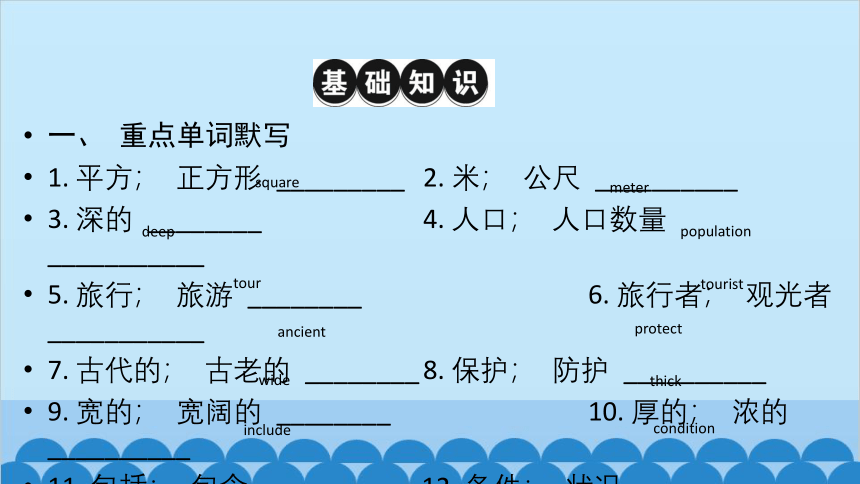
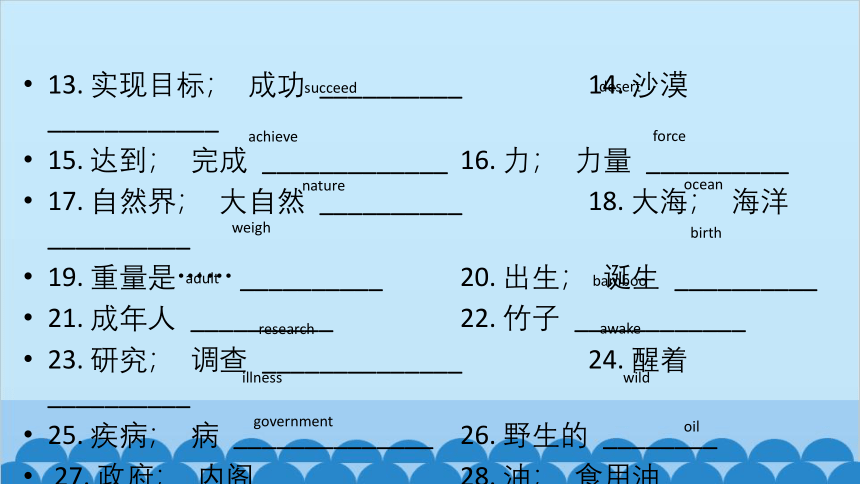
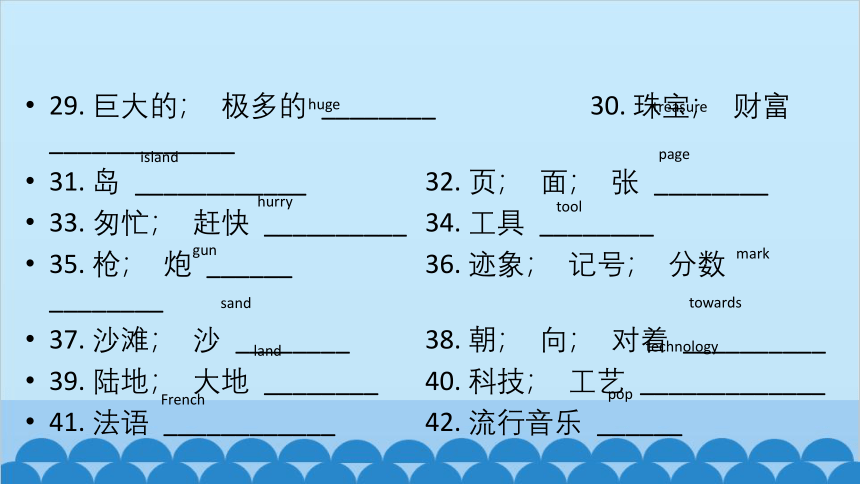

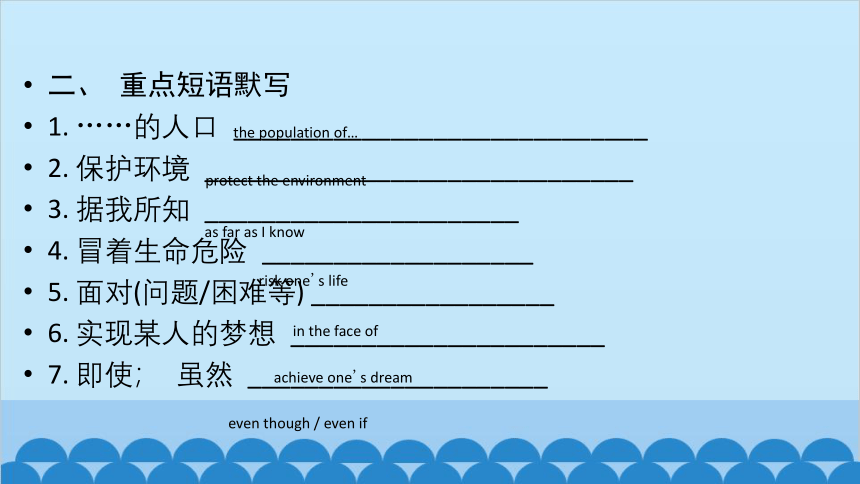
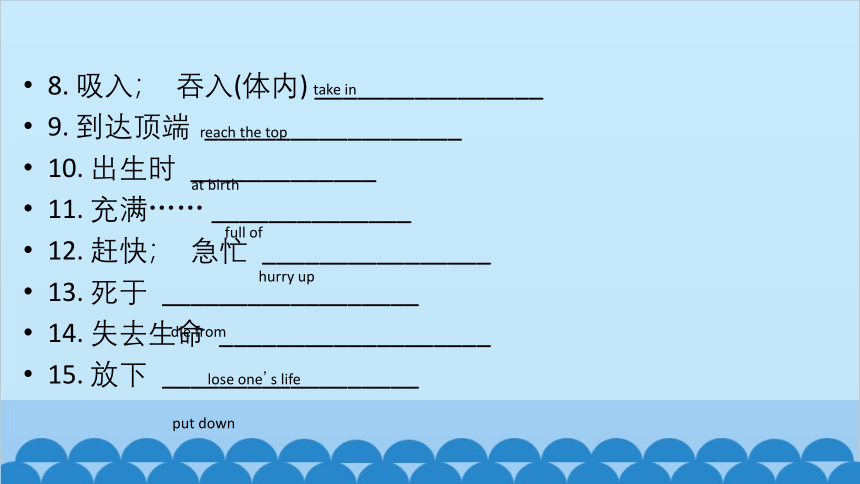
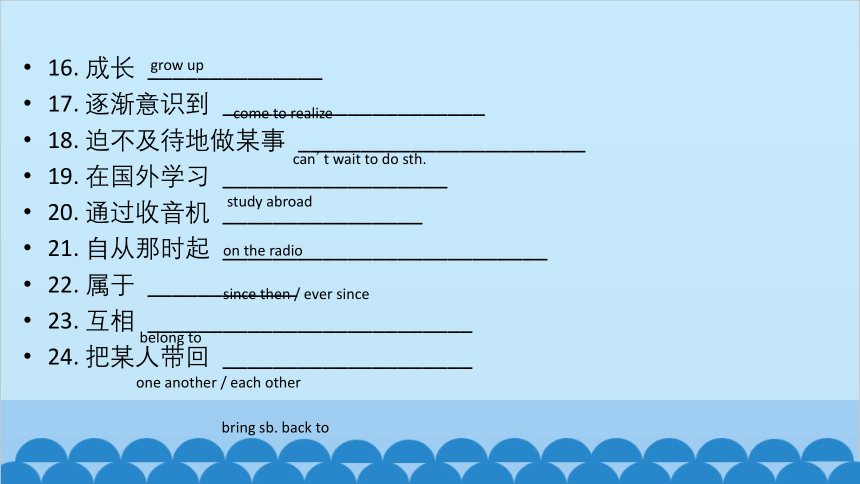
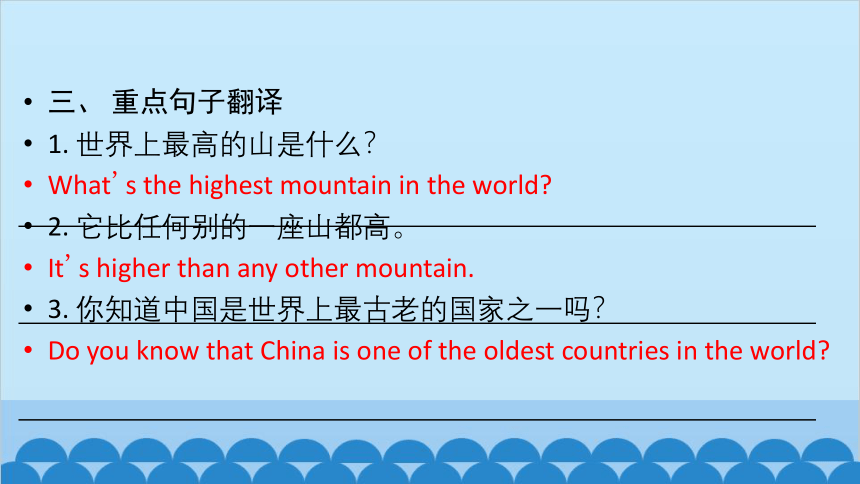
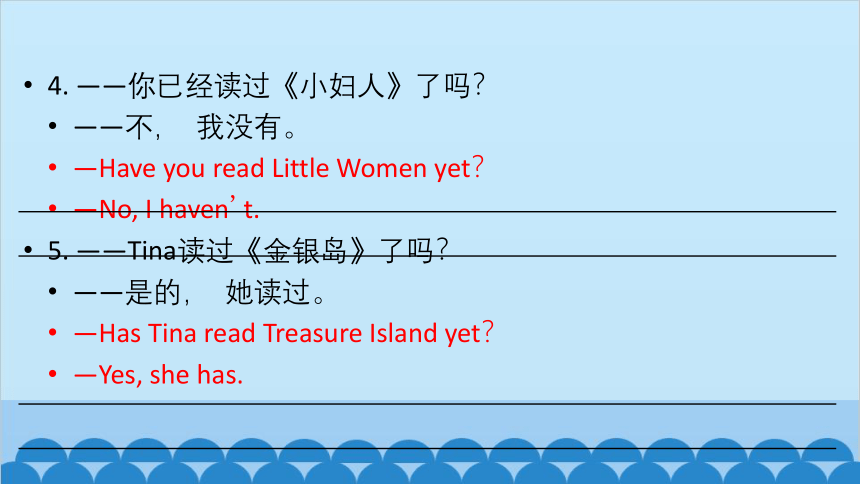
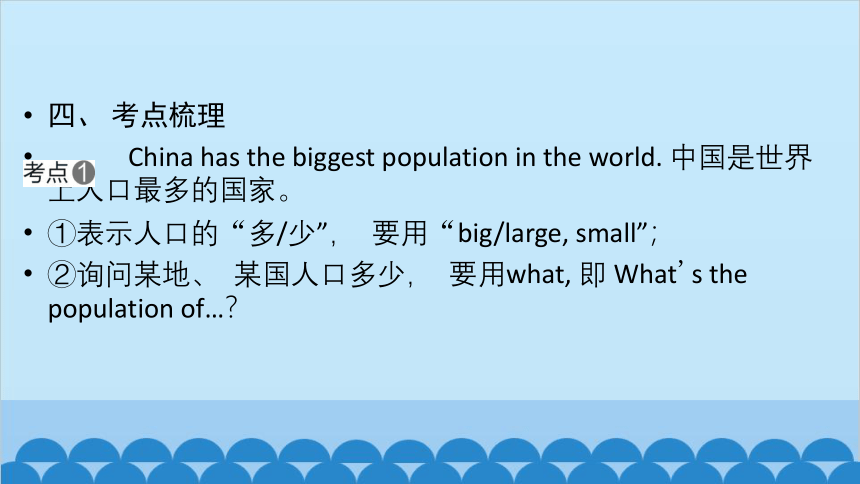
文档简介
(共39张PPT)
八年级下册
Unit 7~Unit 8
基础知识
能力提升
一、 重点单词默写
1. 平方; 正方形 _________ 2. 米; 公尺 __________
3. 深的 ________ 4. 人口; 人口数量 ___________
5. 旅行; 旅游 ________ 6. 旅行者; 观光者 ___________
7. 古代的; 古老的 ________ 8. 保护; 防护 __________
9. 宽的; 宽阔的 ________ 10. 厚的; 浓的 __________
11. 包括; 包含 __________ 12. 条件; 状况 ______________
square
meter
deep
population
tour
tourist
ancient
protect
wide
thick
include
condition
13. 实现目标; 成功 __________ 14. 沙漠 ____________
15. 达到; 完成 _____________ 16. 力; 力量 __________
17. 自然界; 大自然 __________ 18. 大海; 海洋 __________
19. 重量是…… __________ 20. 出生; 诞生 __________
21. 成年人 __________ 22. 竹子 ____________
23. 研究; 调查 ______________ 24. 醒着 __________
25. 疾病; 病 ______________ 26. 野生的 ________
27. 政府; 内阁 _____________ 28. 油; 食用油 ______
succeed
desert
achieve
force
nature
ocean
weigh
birth
adult
bamboo
research
awake
illness
wild
government
oil
29. 巨大的; 极多的 ________ 30. 珠宝; 财富 _____________
31. 岛 ____________ 32. 页; 面; 张 ________
33. 匆忙; 赶快 __________ 34. 工具 ________
35. 枪; 炮 ______ 36. 迹象; 记号; 分数 ________
37. 沙滩; 沙 ________ 38. 朝; 向; 对着 __________
39. 陆地; 大地 ________ 40. 科技; 工艺 _____________
41. 法语 ____________ 42. 流行音乐 ______
huge
treasure
island
page
hurry
tool
gun
mark
sand
towards
land
technology
French
pop
43. 在国外 ____________ 44. 迷; 狂热爱好者 ______
45. 南方的 ___________ 46. 现代的; 当代的 __________
47. 成功(n.) ______________ 48. 唱片; 记录 ____________
49. 介绍; 引见 _____________ 50. 行; 排 ________
51. 属于 ____________
abroad
fan
southern
modern
success
record
introduce
line
belong
二、 重点短语默写
1. ……的人口 _____________________________
2. 保护环境 ______________________________
3. 据我所知 ______________________
4. 冒着生命危险 ___________________
5. 面对(问题/困难等) _________________
6. 实现某人的梦想 ______________________
7. 即使; 虽然 _____________________
the population of…
protect the environment
as far as I know
risk one's life
in the face of
achieve one's dream
even though / even if
8. 吸入; 吞入(体内) ________________
9. 到达顶端 __________________
10. 出生时 _____________
11. 充满…… ______________
12. 赶快; 急忙 ________________
13. 死于 __________________
14. 失去生命 ___________________
15. 放下 __________________
take in
reach the top
at birth
full of
hurry up
die from
lose one's life
put down
16. 成长 ______________
17. 逐渐意识到 _____________________
18. 迫不及待地做某事 _______________________
19. 在国外学习 __________________
20. 通过收音机 ________________
21. 自从那时起 __________________________
22. 属于 ____________
23. 互相 __________________________
24. 把某人带回 ____________________
grow up
come to realize
can't wait to do sth.
study abroad
on the radio
since then / ever since
belong to
one another / each other
bring sb. back to
三、 重点句子翻译
1. 世界上最高的山是什么?
What's the highest mountain in the world
2. 它比任何别的一座山都高。
It's higher than any other mountain.
3. 你知道中国是世界上最古老的国家之一吗?
Do you know that China is one of the oldest countries in the world
4. ——你已经读过《小妇人》了吗?
——不, 我没有。
—Have you read Little Women yet?
—No, I haven't.
5. ——Tina读过《金银岛》了吗?
——是的, 她读过。
—Has Tina read Treasure Island yet?
—Yes, she has.
四、 考点梳理
China has the biggest population in the world. 中国是世界上人口最多的国家。
①表示人口的“多/少”, 要用“big/large, small”;
②询问某地、 某国人口多少, 要用what, 即 What's the population of…?
one of the+形容词最高级+名词复数 最……之一
①使用最高级时常见的词有:… in/of+范围
②常见的修饰比较级的词有:much/a little/a bit/a lot/even/far
The first people to reach the top were Tenzing Norgay and Edmund Hillary on May 29, 1953. 在1953年5月29日, 丹增 诺尔盖和埃德蒙 希拉里首次登上珠峰。
the first people to reach the top 第一批到达山顶的人们
the first (second… )+名词/one+to do sth. 第……做某事的……
protect sth. 保护…… protect the environment 保护
环境
protect… form… 保护……免受……
It's also very hard to take in air as you get near the top. 当你走近山顶, 呼吸就会变得困难。
It's+adj. (for sb.) to do sth. 做某事(对于某人)来说是怎样的
It's +adj. + of sb. + to do sth. 某人这么做真是太…… (形容词修饰某人)
be full of…=be filled with…=fill(v. ) with… 充满……
如:The glass is full of water.=The glass is filled with water=The glass fills with water.
杯子里装满了水。
The babies often die from illnesses and do not live very long. 那些幼崽经常死于疾病, 活不了太长时间。
die from 死于
I've already finished reading it. 我已经读完了。
finish doing sth. 结束某事; 完成某事
有些动词后只能跟动名词作宾语, 常见的此类搭配如下:
What do they think of it?他们觉得它怎么样?
相似用法:How do sb. like…? 某人觉得……怎么样?
现在完成时:表示过去发生或已经完成的动作, 对现在造成的 影响或结果。
(1)现在完成时的基本结构:助动词 have/has + P. P. (过去分词)
(2)常用的标志词有:already (已经), yet (已经、 还), just(刚刚), ever(曾经), never(从不), before(以前), once(一次), twice(两次), three times(三次), so far(到目前为止), in the last/past 10 years(在刚刚过去的10年里)等。
(3)区别:already和yet
①already意为“已经”, 常用于肯定句中, 可放在句中或句末。如:
He has already been in Guangdong for ten years. 他已经在广东十年了。
②yet意为“还, 已经”, 常用于否定句的句末。如:
He hasn't been to Guangdong yet. 他还没去过广东。
五、 单项选择
( )1. — is the population of Dongguan
—I think it's over 10 million.
A. How many B. How much C. What
( )2. Beijing, the capital of China, is one of in the world.
A. the largest cities B. larger city C. the largest city
C
A
( )3. I was the second student the homework on time yesterday.
A. finished B. finishing C. to finish
( )4. —My parents don't understand me. What should I do
—I think it's important you to your parents.
A. for; to talk B. for; talk C. of; to talk
( )5. How busy the street is! It is cars, buses and people.
fill with B. full of C. filled of
C
A
B
( )6. Thousands of people are still dying COVID-19 these days in the world.
A. of B. with C. to
( )7. —It is time to hand in our math homework. you it
—Not yet. It will be OK in a few minutes.
A. Do; finish
B. Are; going to finish
C. Have; finished
A
C
( )8. — do you think of 5G
—I like it! With 5G, we can get the information whenever we want and all things on the earth are at our fingertips(指尖). I think it's fantastic.
A. How B. What C. Which
( )9. Have you finished the new science fiction Bonnie wants to read it, too.
A. read B. to read C. reading
B
C
( )10. In order to the environment, we should stop cutting down the trees.
A. keep B. protect C. make
B
六、 阅读理解 (时文)
Can plants talk?Modern research has found something amazing: They do communicate with each other.
It has been known for some time that plants use chemicals to communicate with each other. This happens when some insects try to hurt a plant. The plant gives out chemicals from the leaves that are being eaten. This is like a warning, or a call for help: “Someone is trying to hurt me!” When another plant gets the chemicals, it starts to give out its own, different chemicals. Some of these chemicals drive insects away. Others attract the wasps(黄蜂)! The wasps kill the insects that are eating the plants. Scientists hope to learn more about this plant warning system, so that we can use it to grow more crops(农作物).
More surprisingly, plants also use sound to communicate. People can't hear these sounds, but plants are making them. Some plants make noises with their roots(根部). Plants like corn do this. Some trees make noises when there is not enough water.
Most surprisingly of all, plants have an amazing system of communication that can connect with nearly every plant in a forest. Scientists call this system the “wood wide web”. The wood wide web is connected underground by fungi(霉菌). It connects the roots of different plants. It is in some ways similar to the Internet we use. Using the wood wide web, plants can share information and even food with each other. However, it may lead to bad results. Plants may spread chemicals to hurt other plants. Perhaps one day scientists will learn how to create a “firewall” to stop plants hurting each other within the wood wide web.
Scientists are learning more every day about the secret ways in which plants talk to each other. Maybe one day we will know enough about plant communication to be able to “talk” with them ourselves.
( )1. What will the plants do when they are hurt by insects
A. They will kill the insects by giving out their own chemicals.
B. They will control the wasps to kill the insects.
C. They will make noises to ask for help.
D. They will produce chemicals as a warning or a call for help.
D
( )2. What does the underlined word “attract” in Paragraph 2 mean
A. Make… get hurt. B. Make… go away.
C. Cause… to come. D. Cause… to die.
( )3. How does fungi make the wood wide web
A. By making noises with their roots.
B. By connecting the roots of different plants.
C. By sharing food and information with each other.
D. By spreading chemicals to each other.
C
B
( )4. From the last paragraph, we can learn that the writer .
A. is hopeful for further studies on plants
B. wants to praise scientists for their great achievements
C. calls on people to protect the plants on the earth
D. encourages people to communicate with plants
A
( )5. What is the best title for the passage
A. The Secret Language of Plants
B. The Study About the Plant Warning System
C. The Plants That Give Warnings
D. Why Scientists Do Research About Plants
A
七、 回答问题 (时文)
It's reported that the height of the world's tallest mountain, Mount Qomolangma, has grown taller. It is now 8848.86 meters above sea level.
However, Mount Qomolangma is facing a big risk caused by human activity. Its ice is melting(融化) because of high air temperature. Moreover, it is facing the problem of microplastics. A recent study found that the mountain is full of plastics. Climbers have left many things there, including the clothing, tents and ropes.
Microplastics take thousands of years to break down on their own. We know that they are making a danger to sea animals. Now people are worried about Qomolangma, because the mountain is also facing the serious pollution.
The rising temperature is also bad for the mountain, as well as its climbers. Another study points out that the glaciers(冰川) around Qomolangma have thinned by more than 100 meters since the 1960s. As the ice melts, cracks(裂缝) in the ice are becoming deeper and more dangerous, making a risk to those who try to climb the mountain, according to Global News.
Landslides(滑坡) are also becoming more likely. Icy rocks or permafrost(永久冻土) help to hold many different parts of the mountain together, according to Professor Joseph Shea at the University of Northern British Columbia, Canada. When this permafrost melts, the risk of dangerous landslides goes up.
1. How tall is Mount Qomolangma now
It is now 8848.86 meters.
2. Who has left the plastics on Mount Qomolangma
Climbers have left the plastics on Mount Qomolangma.
3. How long does it take microplastics to break down on their own
It takes microplastics thousands of years to break down on their own.
4. Why does the rising temperature make a risk to the climbers of Mount Qomolangma
Because as the ice melts, cracks in the ice are becoming deeper and more dangerous.
5. What helps to hold different parts of the mountain together
Icy rocks or permafrost help to hold different parts of the mountain together.
八年级下册
Unit 7~Unit 8
基础知识
能力提升
一、 重点单词默写
1. 平方; 正方形 _________ 2. 米; 公尺 __________
3. 深的 ________ 4. 人口; 人口数量 ___________
5. 旅行; 旅游 ________ 6. 旅行者; 观光者 ___________
7. 古代的; 古老的 ________ 8. 保护; 防护 __________
9. 宽的; 宽阔的 ________ 10. 厚的; 浓的 __________
11. 包括; 包含 __________ 12. 条件; 状况 ______________
square
meter
deep
population
tour
tourist
ancient
protect
wide
thick
include
condition
13. 实现目标; 成功 __________ 14. 沙漠 ____________
15. 达到; 完成 _____________ 16. 力; 力量 __________
17. 自然界; 大自然 __________ 18. 大海; 海洋 __________
19. 重量是…… __________ 20. 出生; 诞生 __________
21. 成年人 __________ 22. 竹子 ____________
23. 研究; 调查 ______________ 24. 醒着 __________
25. 疾病; 病 ______________ 26. 野生的 ________
27. 政府; 内阁 _____________ 28. 油; 食用油 ______
succeed
desert
achieve
force
nature
ocean
weigh
birth
adult
bamboo
research
awake
illness
wild
government
oil
29. 巨大的; 极多的 ________ 30. 珠宝; 财富 _____________
31. 岛 ____________ 32. 页; 面; 张 ________
33. 匆忙; 赶快 __________ 34. 工具 ________
35. 枪; 炮 ______ 36. 迹象; 记号; 分数 ________
37. 沙滩; 沙 ________ 38. 朝; 向; 对着 __________
39. 陆地; 大地 ________ 40. 科技; 工艺 _____________
41. 法语 ____________ 42. 流行音乐 ______
huge
treasure
island
page
hurry
tool
gun
mark
sand
towards
land
technology
French
pop
43. 在国外 ____________ 44. 迷; 狂热爱好者 ______
45. 南方的 ___________ 46. 现代的; 当代的 __________
47. 成功(n.) ______________ 48. 唱片; 记录 ____________
49. 介绍; 引见 _____________ 50. 行; 排 ________
51. 属于 ____________
abroad
fan
southern
modern
success
record
introduce
line
belong
二、 重点短语默写
1. ……的人口 _____________________________
2. 保护环境 ______________________________
3. 据我所知 ______________________
4. 冒着生命危险 ___________________
5. 面对(问题/困难等) _________________
6. 实现某人的梦想 ______________________
7. 即使; 虽然 _____________________
the population of…
protect the environment
as far as I know
risk one's life
in the face of
achieve one's dream
even though / even if
8. 吸入; 吞入(体内) ________________
9. 到达顶端 __________________
10. 出生时 _____________
11. 充满…… ______________
12. 赶快; 急忙 ________________
13. 死于 __________________
14. 失去生命 ___________________
15. 放下 __________________
take in
reach the top
at birth
full of
hurry up
die from
lose one's life
put down
16. 成长 ______________
17. 逐渐意识到 _____________________
18. 迫不及待地做某事 _______________________
19. 在国外学习 __________________
20. 通过收音机 ________________
21. 自从那时起 __________________________
22. 属于 ____________
23. 互相 __________________________
24. 把某人带回 ____________________
grow up
come to realize
can't wait to do sth.
study abroad
on the radio
since then / ever since
belong to
one another / each other
bring sb. back to
三、 重点句子翻译
1. 世界上最高的山是什么?
What's the highest mountain in the world
2. 它比任何别的一座山都高。
It's higher than any other mountain.
3. 你知道中国是世界上最古老的国家之一吗?
Do you know that China is one of the oldest countries in the world
4. ——你已经读过《小妇人》了吗?
——不, 我没有。
—Have you read Little Women yet?
—No, I haven't.
5. ——Tina读过《金银岛》了吗?
——是的, 她读过。
—Has Tina read Treasure Island yet?
—Yes, she has.
四、 考点梳理
China has the biggest population in the world. 中国是世界上人口最多的国家。
①表示人口的“多/少”, 要用“big/large, small”;
②询问某地、 某国人口多少, 要用what, 即 What's the population of…?
one of the+形容词最高级+名词复数 最……之一
①使用最高级时常见的词有:… in/of+范围
②常见的修饰比较级的词有:much/a little/a bit/a lot/even/far
The first people to reach the top were Tenzing Norgay and Edmund Hillary on May 29, 1953. 在1953年5月29日, 丹增 诺尔盖和埃德蒙 希拉里首次登上珠峰。
the first people to reach the top 第一批到达山顶的人们
the first (second… )+名词/one+to do sth. 第……做某事的……
protect sth. 保护…… protect the environment 保护
环境
protect… form… 保护……免受……
It's also very hard to take in air as you get near the top. 当你走近山顶, 呼吸就会变得困难。
It's+adj. (for sb.) to do sth. 做某事(对于某人)来说是怎样的
It's +adj. + of sb. + to do sth. 某人这么做真是太…… (形容词修饰某人)
be full of…=be filled with…=fill(v. ) with… 充满……
如:The glass is full of water.=The glass is filled with water=The glass fills with water.
杯子里装满了水。
The babies often die from illnesses and do not live very long. 那些幼崽经常死于疾病, 活不了太长时间。
die from 死于
I've already finished reading it. 我已经读完了。
finish doing sth. 结束某事; 完成某事
有些动词后只能跟动名词作宾语, 常见的此类搭配如下:
What do they think of it?他们觉得它怎么样?
相似用法:How do sb. like…? 某人觉得……怎么样?
现在完成时:表示过去发生或已经完成的动作, 对现在造成的 影响或结果。
(1)现在完成时的基本结构:助动词 have/has + P. P. (过去分词)
(2)常用的标志词有:already (已经), yet (已经、 还), just(刚刚), ever(曾经), never(从不), before(以前), once(一次), twice(两次), three times(三次), so far(到目前为止), in the last/past 10 years(在刚刚过去的10年里)等。
(3)区别:already和yet
①already意为“已经”, 常用于肯定句中, 可放在句中或句末。如:
He has already been in Guangdong for ten years. 他已经在广东十年了。
②yet意为“还, 已经”, 常用于否定句的句末。如:
He hasn't been to Guangdong yet. 他还没去过广东。
五、 单项选择
( )1. — is the population of Dongguan
—I think it's over 10 million.
A. How many B. How much C. What
( )2. Beijing, the capital of China, is one of in the world.
A. the largest cities B. larger city C. the largest city
C
A
( )3. I was the second student the homework on time yesterday.
A. finished B. finishing C. to finish
( )4. —My parents don't understand me. What should I do
—I think it's important you to your parents.
A. for; to talk B. for; talk C. of; to talk
( )5. How busy the street is! It is cars, buses and people.
fill with B. full of C. filled of
C
A
B
( )6. Thousands of people are still dying COVID-19 these days in the world.
A. of B. with C. to
( )7. —It is time to hand in our math homework. you it
—Not yet. It will be OK in a few minutes.
A. Do; finish
B. Are; going to finish
C. Have; finished
A
C
( )8. — do you think of 5G
—I like it! With 5G, we can get the information whenever we want and all things on the earth are at our fingertips(指尖). I think it's fantastic.
A. How B. What C. Which
( )9. Have you finished the new science fiction Bonnie wants to read it, too.
A. read B. to read C. reading
B
C
( )10. In order to the environment, we should stop cutting down the trees.
A. keep B. protect C. make
B
六、 阅读理解 (时文)
Can plants talk?Modern research has found something amazing: They do communicate with each other.
It has been known for some time that plants use chemicals to communicate with each other. This happens when some insects try to hurt a plant. The plant gives out chemicals from the leaves that are being eaten. This is like a warning, or a call for help: “Someone is trying to hurt me!” When another plant gets the chemicals, it starts to give out its own, different chemicals. Some of these chemicals drive insects away. Others attract the wasps(黄蜂)! The wasps kill the insects that are eating the plants. Scientists hope to learn more about this plant warning system, so that we can use it to grow more crops(农作物).
More surprisingly, plants also use sound to communicate. People can't hear these sounds, but plants are making them. Some plants make noises with their roots(根部). Plants like corn do this. Some trees make noises when there is not enough water.
Most surprisingly of all, plants have an amazing system of communication that can connect with nearly every plant in a forest. Scientists call this system the “wood wide web”. The wood wide web is connected underground by fungi(霉菌). It connects the roots of different plants. It is in some ways similar to the Internet we use. Using the wood wide web, plants can share information and even food with each other. However, it may lead to bad results. Plants may spread chemicals to hurt other plants. Perhaps one day scientists will learn how to create a “firewall” to stop plants hurting each other within the wood wide web.
Scientists are learning more every day about the secret ways in which plants talk to each other. Maybe one day we will know enough about plant communication to be able to “talk” with them ourselves.
( )1. What will the plants do when they are hurt by insects
A. They will kill the insects by giving out their own chemicals.
B. They will control the wasps to kill the insects.
C. They will make noises to ask for help.
D. They will produce chemicals as a warning or a call for help.
D
( )2. What does the underlined word “attract” in Paragraph 2 mean
A. Make… get hurt. B. Make… go away.
C. Cause… to come. D. Cause… to die.
( )3. How does fungi make the wood wide web
A. By making noises with their roots.
B. By connecting the roots of different plants.
C. By sharing food and information with each other.
D. By spreading chemicals to each other.
C
B
( )4. From the last paragraph, we can learn that the writer .
A. is hopeful for further studies on plants
B. wants to praise scientists for their great achievements
C. calls on people to protect the plants on the earth
D. encourages people to communicate with plants
A
( )5. What is the best title for the passage
A. The Secret Language of Plants
B. The Study About the Plant Warning System
C. The Plants That Give Warnings
D. Why Scientists Do Research About Plants
A
七、 回答问题 (时文)
It's reported that the height of the world's tallest mountain, Mount Qomolangma, has grown taller. It is now 8848.86 meters above sea level.
However, Mount Qomolangma is facing a big risk caused by human activity. Its ice is melting(融化) because of high air temperature. Moreover, it is facing the problem of microplastics. A recent study found that the mountain is full of plastics. Climbers have left many things there, including the clothing, tents and ropes.
Microplastics take thousands of years to break down on their own. We know that they are making a danger to sea animals. Now people are worried about Qomolangma, because the mountain is also facing the serious pollution.
The rising temperature is also bad for the mountain, as well as its climbers. Another study points out that the glaciers(冰川) around Qomolangma have thinned by more than 100 meters since the 1960s. As the ice melts, cracks(裂缝) in the ice are becoming deeper and more dangerous, making a risk to those who try to climb the mountain, according to Global News.
Landslides(滑坡) are also becoming more likely. Icy rocks or permafrost(永久冻土) help to hold many different parts of the mountain together, according to Professor Joseph Shea at the University of Northern British Columbia, Canada. When this permafrost melts, the risk of dangerous landslides goes up.
1. How tall is Mount Qomolangma now
It is now 8848.86 meters.
2. Who has left the plastics on Mount Qomolangma
Climbers have left the plastics on Mount Qomolangma.
3. How long does it take microplastics to break down on their own
It takes microplastics thousands of years to break down on their own.
4. Why does the rising temperature make a risk to the climbers of Mount Qomolangma
Because as the ice melts, cracks in the ice are becoming deeper and more dangerous.
5. What helps to hold different parts of the mountain together
Icy rocks or permafrost help to hold different parts of the mountain together.
